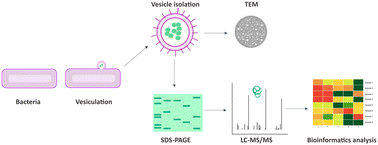The relationship between bacterial outer membrane vesicles and halophilic adaptation
Abstract
Many cells are known to actively release nano-sized outer membrane vesicles (OMVs) that contain bioactive proteins, lipids, and nucleic acids into the extracellular environment. These vesicles have been associated with adaptation to environmental stress in other species, but their role in halophilic salt stress adaptation is not known. This study aimed to isolate and characterize the OMVs of Halomonas caseinilytica KB2 at various salt concentrations [6% (KB2-6), 12% (KB2-12), and 18% (KB2-18)] and to identify the patterns of adaptations to increasing salinity in its structure, protein composition, and expression. Also, a comparison with the composition of OMVs of E. coli, a mesophilic bacterium, was performed. Bioinformatics and statistical analysis were carried out to elucidate the underlying proteome differences that may exist as a result of increasing salinity. The results show that OMV production in H. caseinilytica KB2 is promoted by a decrease in salinity. OMVs also revealed possible structural and metabolic changes happening in the cells which led to the deduction that cells become more stable with increasing salt concentrations. Cell wall integrity, protein expression and folding are important. Although H. caseinilytica KB2 OMVs show cellular changes with changing salt concentration, they may not play a direct role in adaptation to changing salinity.



 Please wait while we load your content...
Please wait while we load your content...